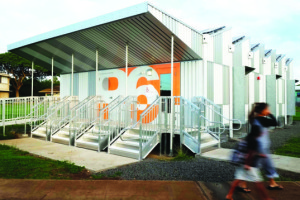Source: andersonanderson.com
Published: April 9, 2015

The structure is topped with a distinctive sawtooth roof that uses north-facing windows to optimize ventilation and natural daylight to the interior.
Click here to watch “Energy Positive Portable Classroom”: https://www.youtube.com/watch?v=EEtt_cZNkR4
LOCATION: Ewa Beach, Hawaii
PROJECT SIZE: 960 sf
BUILDING TYPE: School (classroom), Prefabricated modular steel and wood construction
AWARDS: 2011 Holcim Awards Acknowledgement Prize for North America, international sustainable architecture award by the Holcim Foundation, Zurich 2009 CAE Educational Facility Design Award, Citation Award in “Unbuilt” category. Honored at AIA 2009 National Convention in San Francisco on May 2, 2009 2009 AIA Honolulu Awards for Excellence in Architecture, Merit Award in the “Unbuilt” category 2009 National School Boards Association Award 2008 Winner of “Silver” Spark Design Award
NARRATIVE: One in four students in Hawaii currently study in poor-quality portable classrooms. The states plans to replace 10,000 of these units over the next ten years. This factory-built energy-positive portable classroom provides a high performance, healthy educational environment, while minimizing energy use through careful daylighting and natural ventilation, employing photovoltaic panels to generate substantially more power than consumed. The classroom also serves as an educational tool, with natural forces and systems highlighted, and building performance monitored and broadcast to students inside, as well as to the web. (link) The life-cycle cost is projected lower than previous generation energy-consuming portables. This modular, off-site fabricated, relocatable classroom prototype was commissioned by the Hawaii Department of Education as a new model to replace the state’s current inventory of aging, poor quality and energy inefficient portables. The project was competitively awarded to a design-build team based on highly detailed performance analysis modeling and thirty-year life cycle cost analyses. The building systems include extensive environmental monitoring systems broadcast to the web. A state-funded scientific team is evaluating the building performance through a two-year study. Based on scientific results and post-occupancy evaluation, the building will be revised as required for future units to be placed in numerous highly varied climate ecosystems throughout the state. The easily relocatable building system is desiged with flexibility and options for classroom comfort and energy efficiency in a wide range of climate conditions. Relocatable classrooms are a major presence in Hawaii education planning. The portable classroom is designed to provide an optimized educational environment for students and teachers while advancing sustainable design principles in construction and in classroom learning. The classroom is designed to conserve as well as collect and generates natural resources, including electrical energy, daylight, wind energy, and rainwater. As well as being strong, efficient and conserving, natural forces and resources are highlighted and exposed throughout the structure, and all systems and performance criteria are monitored and broadcast to the web. The building acts as a learning tool for occupants, other schools, and the general public. The combination of maximized photovoltaic surface matched with low energy consumption creates a positive net energy production that is four times the building’s annual consumption.
